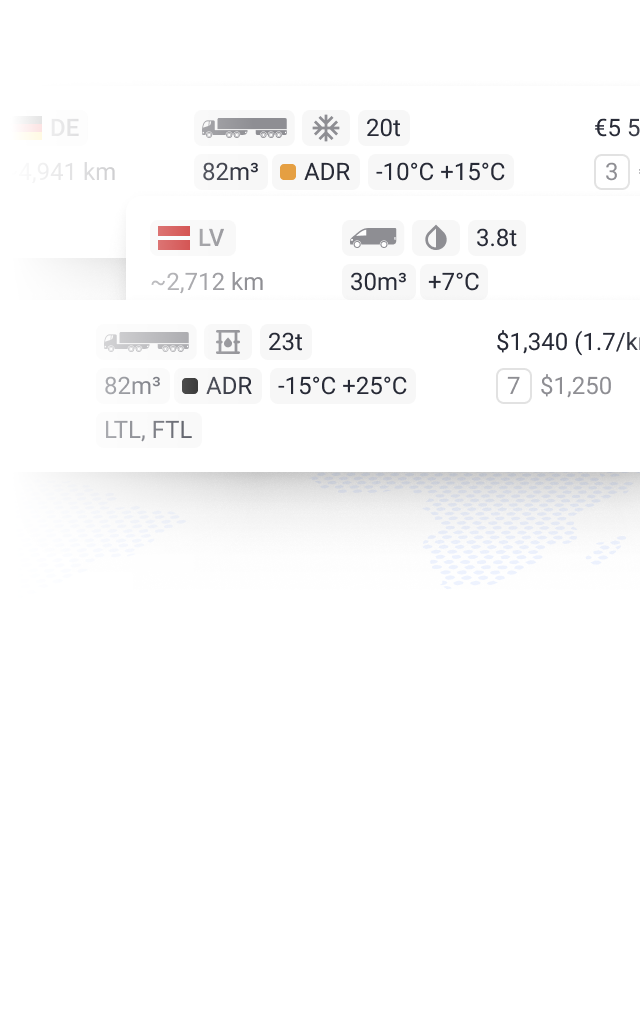
Transport of Groupage Cargo



















Consolidated freight transportation, or LTL (Less Than Truckload), is a shipping format where a single transport container or truck is used to deliver goods from multiple shippers. This solution is ideal for senders who do not need to rent an entire vehicle (FTL — Full Truck Load) because their products do not fill all the available space.
LTL, or consolidated cargo transportation, helps:
- shippers send goods of any size without worrying about fully loading the transport, minimizing unnecessary expenses;
- carriers optimize the use of cargo space, thereby increasing profitability.
The core idea of LTL is the consolidation of consolidated shipments. Carriers combine shipments from several clients in one cargo compartment. This method saves resources for carriers and creates favorable conditions for shippers.
Depending on the specifics of the product, it may require special storage conditions; therefore, logistics experts have developed a classification for cargo. First and foremost, this classification is based on size:
- Small-sized. Goods in small packaging that occupy minimal space in the truck's body. These items can easily be combined with other goods to fill up available space. Such cargo is typically packed in boxes, containers, or individual packages.
- Medium-sized. Larger goods of average size and weight that can still be combined with other shipments. They are usually packed in crates, pallets, or appropriately sized packaging.
- Large-sized. Goods that take up significant space in the truck's body and generally receive priority during loading. Remaining free space is filled with smaller or medium-sized batches.
In addition, when transporting consolidated cargo by road, there is a classification based on cargo characteristics:
- Fragile. Items requiring careful packaging and utmost caution during loading and transport. They are placed in safe areas of the truck where the risk of damage is minimized. Examples include glassware, porcelain, and other breakable materials. These items are not loaded together with potentially hazardous objects (e.g., metal structures).
- Valuable. High-cost products that often require enhanced security measures, such as reinforced packaging. Like fragile goods, valuable cargo demands special attention at every stage of transportation.
- Hazardous. A category that requires strict adherence to transportation rules. This includes flammable substances, chemicals, and other materials that pose a danger to the environment or people. Hazardous goods are transported in sealed containers and must not be loaded with items that could potentially compromise the integrity of their packaging.
- Perishable. Products with a limited shelf life, such as food, pharmaceuticals, biological materials, and plants. In most cases, these require specific temperature control, achieved through refrigerated trucks, insulated vans, or thermally controlled containers.
- Liquid and bulk. In consolidated road transport, these goods are loaded into specialized containers, bags, or drums within the truck’s body.
Cargo is also categorized by weight parameters:
- Lightweight cargo. Items with low weight but large dimensions, such as various types of foam, packaging materials, and textiles. Despite their light weight, they take up considerable space in the vehicle.
- Heavyweight cargo. Goods with high weight but small dimensions, including construction materials, mixes, metal structures, equipment, and instruments. These can be combined with lightweight goods to optimize loading and balance the weight distribution in the truck.
Each type of cargo requires appropriate packaging and specific handling during loading and placement in the vehicle. This is crucial for ensuring the safety of the goods during transit. The type of transport is carefully selected based on the nature of the items being transported.
Consolidated freight transportation by road is a multi-stage process consisting of several key steps:
- Collection. The carrier picks up shipments from various shippers based on the transport agreement.
- Consolidation. The goods are sent to a central warehouse or transfer hub, where they are sorted and combined according to their delivery destination, transport type requirements, and storage conditions.
- Transportation. The vehicle is dispatched toward the destination through a network of logistics hubs.
- Unloading. An intermediate stage in the consolidated freight transport process. The goods are redistributed to other vehicles for further delivery.
- Delivery. At the final destination, the goods are distributed to individual recipients' addresses.
In international consolidated freight transportation, an additional customs clearance stage is included. Transportation companies handle this process, incorporating it and the associated costs into the contract terms.
There are certain nuances involved in this process that transportation companies take into account:
- Transportation conditions. In a single shipment, goods with similar requirements for temperature, humidity, and lighting can be transported together. Additionally, items with different hazard classifications cannot be combined in the same batch.
- Stackability. Efficient use of space within the truck allows carriers to increase revenue. Goods with similar characteristics can be stacked together in the cargo area.
- Storage duration. When consolidating shipments, transport companies group products with matching shelf-life requirements. Perishable goods are transported separately from those suitable for long-term storage.
- Homogeneity of goods. The properties of the transported products are carefully considered. For example, fragile glass items are not shipped alongside metal structures or construction materials.
Small-batch or individual-item shipping is also available. Furthermore, this method of delivery is more cost-effective since the cargo is typically delivered to a temporary storage warehouse for pickup rather than directly to the door. The logistics of consolidated freight transportation go beyond just the delivery process; it’s also important to consider storage conditions at the warehouse, including temperature and humidity levels during the consolidation phase.
Companies choose consolidated freight transportation for the following advantages:
- Safety. All guarantees are outlined in the contract, including insurance and the liability of both parties for the safety of the goods.
- Cost. The sender pays only for the actual space occupied in the truck (cargo compartment), which is significantly cheaper than renting the entire vehicle (container).
- Insurance. When shipping products, insurance is mandatory for each unit of cargo.
- Door-to-door delivery. Transport company staff pick up the goods at the specified location and deliver them to a temporary storage warehouse for collection.
This shipping format is used by small, medium, and large businesses alike.
This is the most cost-effective way to ship products over any distance. Shippers only pay for the space their goods occupy, and the cost is determined based on several factors:
- weight, volume, and dimensions;
- packaging and product packaging type;
- insurance;
- necessity of customs clearance (for international shipments);
- stackability of the cargo;
- temperature requirements during transport;
- method of delivery: to a temporary storage warehouse or door-to-door;
- availability of other additional services.
The cost of consolidated freight transportation is set by logistics companies. Each organization has its own tariff, which is calculated based on the listed factors, as well as the type of transport, storage conditions, and route distance.
Selecting a company for consolidated shipments is a critical task, as it directly affects the speed, cost, and safety of delivery. Below are key criteria to consider when choosing a carrier:
- Experience and market reputation. Transportation companies with proven experience and a solid reputation typically have a better understanding of logistics nuances and streamlined processes. Checking their reputation through customer reviews, ratings, and certifications can provide a clearer picture of their expertise and reliability.
- Network reach and route geography. Consolidated shipments often pass through distribution centers and intermediate logistics hubs. The wider the company’s network, the more opportunities there are for efficient routing and reduced delivery times.
- Delivery speed. Timely delivery is crucial, especially for industrial components or retail goods.
- Technology and logistics transparency. Real-time tracking systems enhance control over logistics. Transparency and the ability to monitor shipments at every stage are key factors in planning and coordinating processes effectively.
- Insurance and guarantees. Transporting goods involves risks of damage or loss. Insurance helps ensure the safe delivery of consolidated shipments, and guarantees should be clearly outlined in the contract.
- Pricing and transparent calculations. The cost of transportation should be fair and proportional to the services provided. Clear and transparent billing without hidden fees or additional charges is essential.
Selecting a company for consolidated shipments is a strategic decision that impacts the efficiency of your logistics operations.
A suitable transportation and forwarding company specializing in consolidated shipments can easily be found in the Roolz directory. Add your company, find a reliable logistics partner, and conveniently organize freight transportation on the Roolz platform!
What is Less Than Truckload (LTL)?
Consolidated freight transportation, or LTL (Less Than Truckload), is a shipping format where a single transport container or truck is used to deliver goods from multiple shippers. This solution is ideal for senders who do not need to rent an entire vehicle (FTL — Full Truck Load) because their products do not fill all the available space.
LTL, or consolidated cargo transportation, helps:
- shippers send goods of any size without worrying about fully loading the transport, minimizing unnecessary expenses;
- carriers optimize the use of cargo space, thereby increasing profitability.
The core idea of LTL is the consolidation of consolidated shipments. Carriers combine shipments from several clients in one cargo compartment. This method saves resources for carriers and creates favorable conditions for shippers.




Add your company


 en
en fr
fr de
de hi
hi pl
pl es
es tr
tr uk
uk